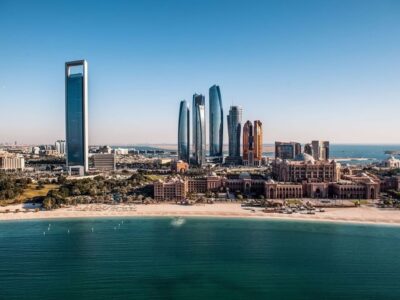The UAE’s gross domestic product (GDP) is expected to have grown by nearly 7.6 per cent last year, according to official national statistics.
The Central Bank of the UAE (CBUAE) issued its 2022 Annual Report, highlighting its progress and initiatives to bolster monetary and financial stability throughout the year.
The CBUAE projects real output growth to slow to 3.9 per cent in 2023, largely reflecting a decline in oil production partially offset by the strong performance of the non-oil sector.
UAE GDP forecasts
Growth is projected to increase to 4.3 per cent in 2024, owing to a better performance in both the oil and non-oil sectors.
The report highlighted the CBUAE’s efforts to enhance monetary stability and the resilience of the financial sector and to support economic activity in the UAE.
It also shed light on economic developments observed locally, regionally and globally throughout the year, noting that the UAE was among the world’s best performing economies, supported by the decisions and directives of the wise leadership, as well as its undertaking of proactive measures and the reopening of the economy following the Covid 19 pandemic.
The impressive GDP growth is supported by significant activity across all sectors, and is among the highest globally as international markets observed a slowdown in economic growth due to increases in interest rates and geopolitical tensions.
Additionally, despite the sharp rise of inflation globally in light of the pressures on supply chains and the rise in commodity prices, inflation in the UAE remained well below the international average at 4.8 per cent with an expected decline in 2023.
In light of expected global economic downturn and a potential recession, the CBUAE, led by Sheikh Mansour bin Zayed Al Nahyan, Vice-President, Deputy Prime Minister, Minister of Presidential Court, and Chairman of the Board of Directors of the CBUAE, continued to implement macro and monetary precautionary policies.
This is in keeping with the UAE government’s strategic roadmap which looks to maintain the country’s competitiveness, ensure robust economic growth, and develop job opportunities for UAE nationals.
The report divulges on the removal of temporary Covid-19 support measures by the Central Bank which sought to support borrowers in combatting the negative impacts of the pandemic.
The decision reflects the return of the banking sector to pre-pandemic levels of profitability and financial strength.
According to the report, the banking sector continued to support economic growth through private-sector lending. Banking sector assets and gross written premiums in the insurance and banking credit sector rose, while the CBUAE conducted regular asset quality assessments.

In an effort to reinforce its role as a regulator of the financial and insurance sector in the United Arab Emirates, the Central Bank strengthened regulatory frameworks on licensed financial institutions, particularly in the areas of corporate governance and risk management for insurance companies, which have contributed to the development of the regulatory environment of insurance companies and related professions operating in the United Arab Emirates.
The report also states that under its newly established regulatory framework, the Central Bank granted licences to specialised banks, stored value facilities, and retail payment service providers.
At the same time, the United Arab Emirates posted a surplus of AED169.6bn ($46.2bn) in the first nine months of 2022.
The impressive growth represents an increase of 165 per cent increase from the same period of 2021.
National revenues from January to September were AED453.7bn ($123.5bn), due to high oil prices and non-oil growth.








